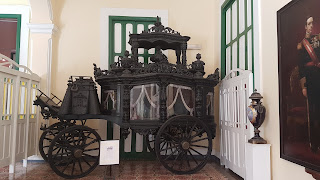It was founded in 1828 by settlers from North America, France and England and quickly became an important city. It was the second city, after Habana, to get a railroad, which revolutionized their ability to ship the sugar produced by the local plantations. In 1889 it became the first city in Cuba to have electric lighting, and one of those early generators is on display in one of the many museums in town.
Cardenas boasts the first statue dedicated to Columbus in all of the Americas, and it is where the Cuban flag was first raised after the second war of independence from Spain in 1898.
So many of the beautiful buildings in this town are falling apart from neglect, no doubt due mostly to lack of money to make the repairs. But there are also some gems hidden away.
Small businesses are popping up all over, with enterprising people using their homes to provide mostly street food. We had a pizza each for lunch, costing us a total of $30 CUPs, which is equivalent to $1.25 US. Unbelievable, but really tasty.
We visited the Museo Oscar Maria de Rojas, the oldest museum in Cuba, which is housed in a hotel built in 1862 in true Spanish style.
It holds a mind boggling collection of items – some truly historical for Cuba or Cardenas, some just random collections of things like shells, butterflies, international currencies, and a shrunken head! These were some of our favourite items.
The propeller from the plane that made the first flight from Key West to Havana, and the replica of that plane.
This is a throne from the Masonic Temple that used to be in Cardenas. It was donated to the museum when the lodge left here and moved to Havana.
A picture made completely of shells
This funeral carriage is carved mahogany. It was only used by the rich and powerful, of course, and their wealth was further demonstrated by the number of horses used to pull the carriage....the richer the dead person, the more horses they used.
Our guide Jesus (pronounced Heesus) was thoroughly entertaining, and provided us with so much information about the exhibits that we were exhasted just trying to take it all in. We sat for a bit in the square outside to recover, surrounded by locals – all on their smart devices, taking full advantage of the free wifi hotspot. Some things don’t change, no matter where you are!


















No comments:
Post a Comment